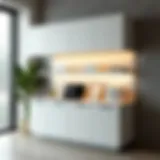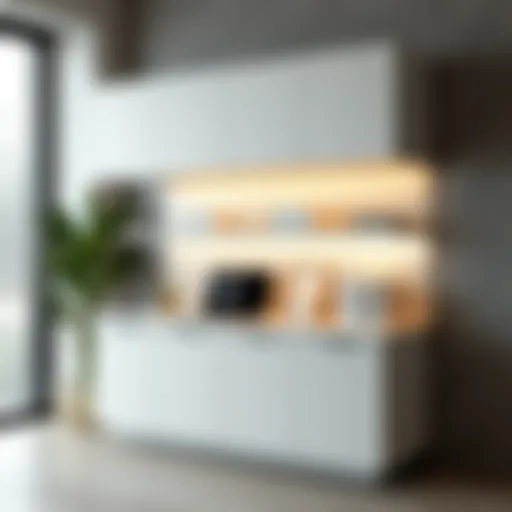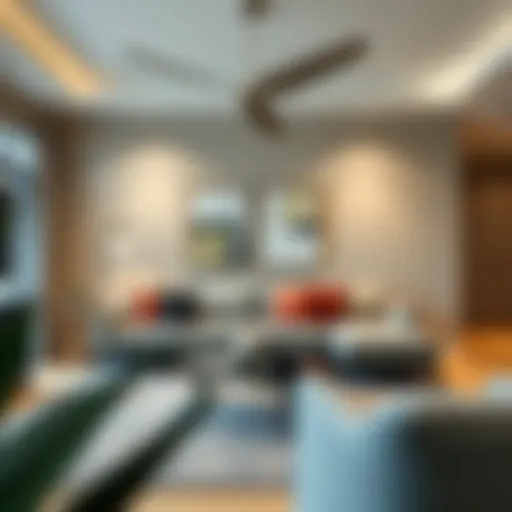The Ultimate Guide to Choosing Throws for Your Home
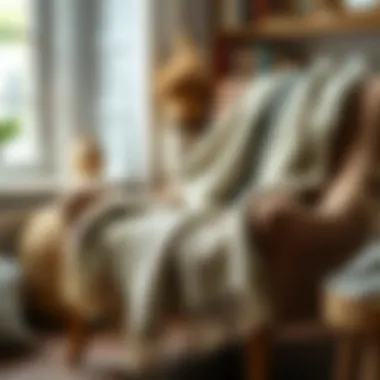

Intro
In the ever-evolving world of interior design, throws have emerged as not just accessories, but essential elements that can transform a living space. Unlike an old sweater you might toss over the back of a chair, today’s throws come in a myriad of choices that set the tone of any room. Whether you’re dressing up a bland sofa or seeking warmth on a chilly evening, the right throw can make all the difference. Let’s face it, no one wants to live in a space that feels cold or unwelcoming, and that’s where these cozy pieces come into play.
Grasping the intricacies of throws may seem trivial, but it’s much like finding the right pair of shoes—you want comfort, style, and longevity. A well-chosen throw not only enhances aesthetic appeal, but also beckons people to sit down and stay awhile.
In this guide, we will delve into the world of throws, exploring materials, styles, and the latest trends that are currently making waves in the design community. By understanding these layers, readers—be they homeowners, renters, or seasoned design aficionados—will be equipped to make informed choices that elevate their interiors.
From the practical aspects of function to sustainability, this exploration provides a rounded view that underscores the significance of throws in today’s living areas. Ready to dive in? Let’s uncover the beauty and utility of this often-overlooked item.
Prelude to Throws
In the ongoing pursuit of creating comfortable and aesthetically pleasing living environments, throws play a crucial yet often underappreciated role. These versatile pieces not only serve a practical purpose but also contribute significantly to the overall ambiance of a room. Whether tossed over the back of a sofa or draped casually at the foot of a bed, throws have the power to transform the feel of a space, making it cozier, more inviting, and visually appealing.
Defining Throws
Throws are essentially lightweight blankets, often made from a variety of materials, designed for both warmth and decoration. Unlike heavier blankets or duvet covers, throws are smaller in size, which makes them easy to handle and style. Typically rectangular, they come in various dimensions but are most commonly found at 50 by 60 inches or thereabouts, offering enough coverage to curl up with while still being manageable.
What distinguishes throws from other types of blankets is their dual functionality. They are intended not only for keeping warm but also for adding flair to your home decor. With their rich textures, colors, and patterns, throws can express personal style while also blending seamlessly with existing decor. This nimbleness is what makes throws an essential component in the toolkit of home decorators and design enthusiasts alike.
The Role of Throws in Home Decor
When it comes to enhancing home interior designs, throws are like the icing on the cake. They lend character to a blank canvas, helping to define the style of a room. For homeowners and renters, they present an opportunity to infuse a touch of personal flair without requiring a full redesign.
In a living room setting, a vibrant throw on a neutral-colored couch can serve as a focal point, drawing the eye and compelling guests to notice the warmth of the environment. Similarly, a subtle patterned throw in a bedroom can add layers of texture, creating a more visually rich space while ensuring comfort.
"The right throw can make a room feel complete, wrapping it in a sense of warmth and style."
Moreover, throws can function as transitional pieces. During colder months, cozy options can make chilling indoors much more pleasant. Conversely, lightweight cotton throws can introduce a breezier feel during hotter seasons, ensuring that your space adapts to the changing weather while remaining stylish.
Material Matters
When it comes to buying throws, understanding the various materials can make all the difference between a purchase that enhances your living space and one that falls flat. Different fabrics carry distinct properties which affect comfort, durability, and aesthetics. Therefore, doing your homework on materials is essential. This section will delve into the types of fabrics commonly used in throws and the importance of sustainability in their production, helping you make informed choices as you elevate your home's decor.
Types of Fabric Used in Throws
Cotton
Cotton stands out as a popular choice for throws due to its versatility and breathability. Being a natural fiber, it offers a soft touch, making it ideal for year-round use. One major appeal of cotton is its easy maintenance; it can be conveniently machine washed without compromising quality. However, while it’s durable, cotton can be prone to wrinkling, which might not be desirable for everyone.
On the other hand, it's perfect for those who appreciate a classic feel and a variety of prints and colors. With cotton, you can find everything from simple, clean designs to vibrant patterns. This fabric’s accessibility and broad appeal make it a beneficial option for anyone looking to enhance their living space with comfort and style.
Wool
Wool throws offer a unique blend of comfort and warmth, ideally suited for cooler climates. The natural insulating properties of wool make it an excellent choice for cozying up on a chilly evening. A standout feature of wool is its ability to regulate temperature, keeping you warm without overheating.
However, wool is not without its drawbacks. Some folks find it can be itchy against bare skin, which may not work for everyone. It's important to note that while wool requires special care—often needing dry cleaning or gentle washing—the investment in a quality wool throw can pay off due to its longevity and robustness.
Cashmere
Cashmere exudes luxury and elegance, transforming any living space into a refined oasis. Known for its incredibly soft texture, cashmere throws are particularly sought after for gifting or upscale decor. The unique feature of cashmere is its warmth without bulk; it feels light yet provides significant insulation.
That being said, cashmere can come with a hefty price tag and requires delicate care, often calling for hand washing or dry cleaning. Because of these considerations, cashmere is best suited for those willing to invest in a piece that embraces both comfort and style in equal measure.
Acrylic
Acrylic throws have gained favor for their affordability and ease of care. Designed to mimic the softness of wool, acrylic is lightweight and can be made in a plethora of colors and patterns, making it a versatile choice for any decor style. One of its key characteristics is that it resists wrinkling and fading, which can be quite beneficial for busy households.
But acrylic does have its downsides. It may not provide the same warmth as natural fibers, which could be a turnoff if you're specifically looking for coziness. That said, it's often a brilliant choice for an easy-to-maintain, colorful accent that can liven up any room.
Blends
Blended fabrics, like cotton-polyester or wool-acrylic mixes, combine the virtues of different materials to create throws that offer the best of both worlds. For instance, a cotton-polyester blend can provide the breathability of cotton with the durability and wrinkle resistance of polyester. This adaptability makes blends an attractive choice for those who may struggle to pick one fabric over another.
When it comes to unique features, the blends can appeal to a wider audience due to their varied textures and finishes. They can be both affordable and luxuriously soft, satisfying multiple preferences while fitting into a range of budgets.
Sustainability in Throw Materials
As more consumers become conscious of their environmental impact, sustainable materials are proving to be significant players in the throw market. Not only do they support eco-friendly practices, but they also nudge manufacturers towards more responsible production methods.
Organic Options
Organic throw options signify a shift towards environmentally-conscious purchasing as they are made from fibers grown without harmful pesticides or synthetic fertilizers. This is critical for both human health and the environment. Organic options often feel more comfortable and breathable, presenting a healthy alternative to conventional products.
However, these products can come with a higher price point, which might be a barrier for some consumers. Yet, investing in organic throws can be viewed as supporting sustainable practices that promote long-term benefits for the planet.
Eco-Friendly Production Methods
Embracing eco-friendly production methods entails more than just selecting the right fabric; it involves scrutinizing how that fabric is produced. These methods minimize waste and pollution, often focusing on energy efficiency. Manufacturers that utilize eco-friendly techniques often gain trust and loyalty from consumers who prioritize sustainability.
Despite its benefits, navigating the landscape of eco-friendly practices can be perplexing. Transparency in production is crucial; companies that clearly communicate their methods and sourcing will likely stand out in this burgeoning market. By prioritizing these ethical options, you not only contribute to a healthier environment but also support a progressive industry mindset.
Styles and Designs
Styles and designs play a pivotal role in the overall aesthetic and functional value of throws, making them an essential element in any thoughtful decor scheme. The significance lies not just in how a throw looks but also how it interacts with the space it occupies. With the right choice, a throw can become a focal point or seamlessly integrate into existing decor, bringing both warmth and character.
Popular Throw Styles
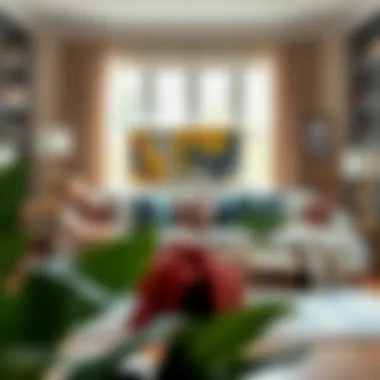
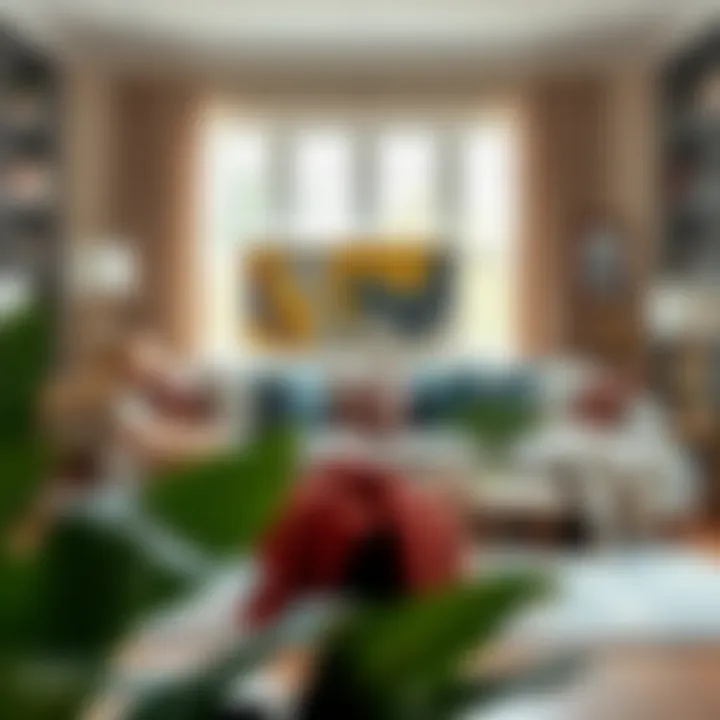
Classic
The classic style of throws is akin to the enduring elegance of a Timeless novel. Characterized by simple yet sophisticated designs, classic throws often feature solid colors or subtle patterns. Their contribution to a living space is substantial; they provide an air of refinement and warmth that is hard to beat. One key characteristic of classic throws is their versatility—they fit well in various environments, from rustic homes to modern flats.
The unique feature of classic throws is their ability to evoke a sense of nostalgia, making them a popular choice among many homeowners. They often pair beautifully with traditional furniture styles and can enhance the coziness of any room. The downside may be their conservative appearance, which might not appeal to those seeking boldness in their decor. Nonetheless, classic throws remain a staple that never truly goes out of style.
Modern
Modern throws are defined by clean lines and innovative materials. This style reflects contemporary themes, often incorporating bold colors or unique textures. Their contribution to interior design is to provide a striking contrast to more traditional items, which can help elevate a space. One key characteristic of modern throws is the use of unconventional shapes and materials like faux fur or chunky knits.
The unique feature of modern throws lies in their capacity to add a fresh, dynamic vibe to any room. They are especially beneficial for those looking to inject a bit of personality into minimalist or industrial settings. However, their boldness can sometimes overshadow other elements in a room, which is a consideration to keep in mind when selecting a throw.
Bohemian
A bohemian throw speaks to individuality, embracing a mix of colors, patterns, and textures. This style is often characterized by eclectic design elements that create a relaxed and inviting atmosphere. The contribution of bohemian throws to interior spaces is significant, as they infuse character and a sense of travel or adventure. One most notable trait of bohemian throws is their artisan appeal, often handcrafted and rich in cultural references.
The unique feature of bohemian throws is their ability to tell a story, making them a beneficial choice for those who want their space to reflect personal experiences and tastes. On the downside, the variety of patterns may sometimes clash with more formal decor, so homeowners should consider the overall cohesiveness of their design choices.
Minimalist
Minimalist throws embody the "less is more" philosophy, focusing on simple designs and understated elegance. Their contribution to a space is found in their ability to create a sense of calm and order. A hallmark of minimalist throws is their neutral color palette, often comprising whites, grays, and subtle earth tones.
The unique feature of minimalist throws is how they can enhance the serenity of a room without overwhelming it. They are a great choice for those who prefer a clutter-free environment. However, the simplicity that defines this style might come off as bland to some, and therefore careful selection is paramount to achieve the desired aesthetic.
Patterns and Colors
Patterns and colors significantly influence the ambiance and mood created by throws. They can either blend seamlessly with the surrounding decor or stand out boldly as statement pieces. Understanding the psychological effects of colors and the visual impact of different patterns can assist in making informed choices that elevate the overall design of a space.
Solid Colors
Solid colored throws are often chosen for their timelessness and versatility. They serve as a strong, complementary backdrop for other design elements in a room. The key characteristic of solid colors is how they can harmonize with various palettes and textures.
The unique advantage of solid color throws lies in their ability to convey sophistication while remaining understated. This makes them a beneficial choice in both minimalist and eclectic spaces, offering the flexibility to adapt over time. However, the downside is that they can sometimes lack the vibrancy or interest that patterns provide.
Geometric Patterns
Geometric patterns in throws can introduce a modern flair that invigorates a space. These patterns often play with shapes and symmetry, creating visual interest that can be captivating. The key characteristic of geometric patterns is their ability to make a statement while still maintaining a modern aesthetic.
The unique feature of geometric patterned throws is their capacity to draw the eye and create focal points in a room. This makes them a stellar choice for spaces that could benefit from a bit of character. However, they might clash with other patterns if not carefully coordinated, so it’s crucial to consider surrounding elements.
Floral Designs
Floral designs in throws evoke the charm and freshness of nature. The flowing patterns can bring vibrancy and life into a room. The key characteristic of floral designs is their use of diverse colors and shapes, which can suit various decor styles from vintage to contemporary.
The unique appeal of floral throws lies in their refreshing quality, making them a perfect choice for spring or summer decor. They can add personality and warmth to spaces lacking in visual stimulation. On the contrary, the busyness of some floral designs might overwhelm a minimalist setting or clash with already established patterns.
Selecting the Right Throw
When it comes to accessorizing your living space, throws are like the icing on a cake. They are not just for warmth; they have the potential to enhance the visual appeal of your interiors significantly. Selecting the right throw is essential for achieving the desired ambiance, contributing to both comfort and style. It's a matter of choosing fabrics, sizes, and styles that resonate with your personal vibe while also fitting seamlessly into your space.
Understanding the right throw goes beyond just fabric and color; it encompasses consideration of how a throw complements the areas where it will reside. Be it a cozy corner of the living room or a serene bedroom retreat, choosing the right throw can elevate your surroundings in no time.
Considerations for Size and Fit
Standard Sizes
When contemplating throws, standard sizes come into play as a foundational aspect. Typically, throws measure around 50 x 60 inches, making them versatile additions for a range of settings. This uniformity in sizing presents a benefit; it ensures that they are easy to use without worrying about fit. Standard sizes cater to broader markets, making them widely available and often more affordable.
However, the downside can present itself when standard sizes do not meet your specific needs; for example, a larger seating area may require a grander throw. Nevertheless, the universal appeal and vast selection often found in standard sizes make them an excellent choice for many environments.
Custom Options
On the flip side, custom options stand out for those seeking something tailored to their unique taste or functional requirements. Custom throws allow individuals to select dimensions, fabrics, and even personalized designs—perfect for ensuring that every detail fits within the curated aesthetics of your space. This aspect is highly beneficial for individuals who might have specific needs that standard throws can’t accommodate.
Nonetheless, the cost can be a notable disadvantage. Custom throws usually command a higher price point compared to their standard counterparts, reflecting the bespoke service involved. Still, for many, the opportunity to create a throw that perfectly harmonizes with their decor can outweigh the expense.
Adapting Throws to Different Spaces
Living Room
In the living room, throws can serve multiple purposes. Beyond functionality, they add texture and color, transforming a straightforward seating arrangement into a stylish lounging area. A carefully selected throw on your sofa can create a welcoming atmosphere. Consider options like knitted or chunky throws that can add depth to the room. The visual appeal definitely makes them a favored choice.
The unique feature of throws in living rooms is their ability to switch the mood of the space without requiring a complete overhaul. You may choose light, airy colors for summer or rich hues in the fall, demonstrating versatility in decor. However, one must keep in mind that with high traffic areas, maintenance is crucial to keep the throws looking fresh and inviting.
Bedroom
Throws in the bedroom add a note of warmth and comfort that can enrich your daily routines. Drape a soft, plush throw across the bottom of your bed or on a chair to create a cozy reading nook. Unlike living rooms, the bedroom’s ambiance leans more towards tranquility, making muted or pastel colors a popular and suitable choice.
The strength of throws in bedrooms lies in their comfort factor. They provide not only a touch of style but also warmth during chilly nights. However, too many layered throws might create a cluttered look, so it’s wise to stick to a few well-chosen pieces that truly enhance the space.
Outdoor Spaces
Outdoor areas present a unique landscape for throws; they can transform patios or balconies into inviting havens. For these spaces, the key characteristic is durability. Throws suited for the outdoors should resist fading and withstand the elements. Materials like acrylic or specially coated fabrics can stand the test of time against sun exposure and moisture.
While an outdoor throw elevates the aesthetic of the space, it also has functional benefits. They can keep you warm on cool evenings while enjoying a sunset. The trade-off, however, may be limited choices in design and pattern compared to indoor throws. Still, the right outdoor throw can enhance your gatherings—turning any occasion into a cozy affair.
Care and Maintenance
Maintaining the appeal and comfort of your throws is essential not only for prolonged use but also to preserve their aesthetic value. Whether you're snuggling on the couch during a cold evening or using a throw as a decorative layer on your bed, good care can significantly enhance the lifespan of these cozy items. Proper maintenance avoids pitfalls like fading, wear, or unwanted odors, ensuring that your throws remain a beautiful part of your living space for years to come.
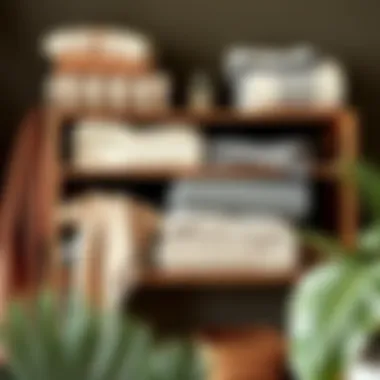
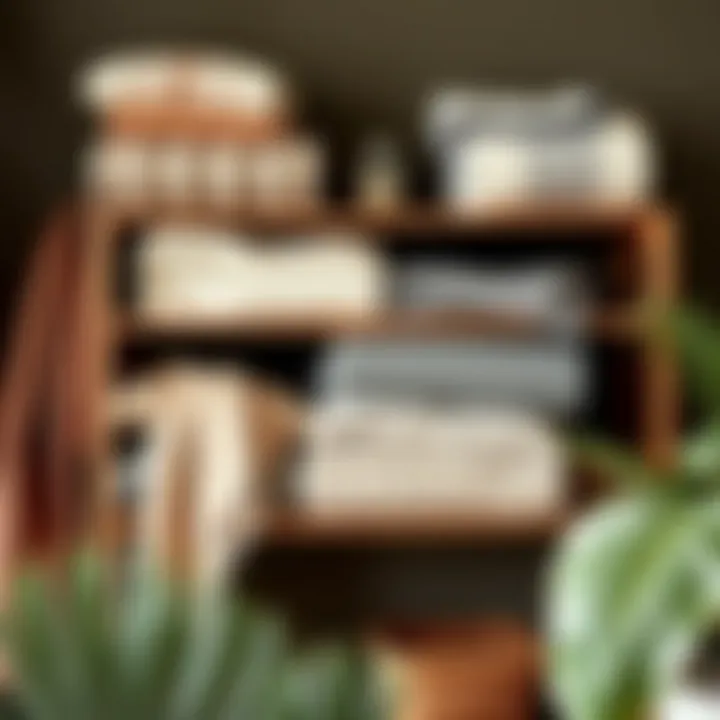
Cleaning and Washing Tips
Machine Washing vs. Hand Washing
When it comes to keeping your throws clean, the choice between machine washing and hand washing can be a tough nut to crack. Machine washing is often seen as the quicker and easier option, particularly for larger items like blankets that can be cumbersome to wash by hand. Most machine-washable throws come with care labels that specify temperature settings; following these guidelines can help maintain their original softness and texture. However, what makes hand washing stand out is the tenderness it offers delicate fabrics. It allows you to control the intensity of cleaning, which can prevent pilling or fraying that machine washing might cause.
"For those wishing to preserve the quality of high-end materials, hand washing is undeniably the gentler approach."
While hand washing takes more time, it can be less stressful for fabrics like cashmere or specific blends that don't respond well to agitated tumbling. Balancing convenience and care is key here.
Drying Techniques
After washing, how you dry your throws plays a major role in how well they'll hold up over time. Air drying is the safest bet for all types of throws, allowing them to dry naturally without the risk of shrinkage that can occur in the dryer. Using a clothesline or laying them flat can help maintain their shape and softness, especially for heavier materials like wool that may stretch when wet.
On the other hand, if you're short on time, a tumble dryer on a low heat setting can work—just make sure to add dryer balls to help fluff the fabric and reduce creasing.
Avoiding excessive sunlight during the drying process is also wise, as UV rays can fade colors and degrade fibers over extended periods. In short, while it may take a little longer, air drying ensures your throws remain fresh and vibrant for those cozy nights ahead.
Preventing Wear and Tear
Storage Solutions
How you store your throws can be the difference between a cozy blanket and a sad, worn-out piece of fabric. Proper storage keeps them away from potential damage, such as dust, moisture, or even moths that might fancy a snack. Using breathable bags or bins can maintain their integrity, while avoiding plastic and keeping them in a cool, dry place helps prevent mold or mildew.
Additionally, rolling your throws instead of folding them can help avoid unsightly creases, maintaining their appeal throughout the year. When the season changes, make sure to refresh the storage environment, especially if they were tucked away due to warmer weather.
Usage Tips
When it comes to using your throws, a little common sense goes a long way. If you're using them outdoors, be mindful of the weather conditions. Taking joy in a chilly evening on your patio is fantastic, but be careful about windy days—a gust can send your beloved throw careening across the yard. Similarly, consider setting limits on food and drink usage when you're cuddling up with your throw. Spills happen, but regular cleanings—if done early—can save your fabric from permanent stains.
Also, rotating the throws you use in different seasons can aid in reducing wear. Throwing a lightweight cotton throw over a chair in summer lets you put your heavier wool into hibernation, keeping both in tip-top shape. In short, thoughtful usage can extend the longevity of your throws and maintain their warmth and beauty.
Where to Buy Throws
Finding the right throw to complement your living space is more than just browsing through stores or websites. The where plays a significant role in this process, as it affects not only your shopping experience but also the quality and uniqueness of the throws you may acquire. Whether you opt for online shopping or decide to visit brick-and-mortar stores, each method has its own merits as well as considerations to keep in mind.
Online Retailers vs. Brick-and-Mortar
Shopping for throws online has become a favored choice for many, thanks to the convenience and variety it offers. Websites like Amazon, Wayfair, and Etsy provide extensive selections that allow you to explore different styles, materials, and prices without leaving the comfort of your home.
Benefits of Online Shopping:
- Expansive Selection: You can often find unique options from various sellers, including global artisans, that aren't available locally.
- Convenience: You can shop any time of day without the need to deal with the hassle of traffic or crowded stores.
- Comparative Shopping: It's easy to check prices and read customer reviews to ensure you’re making the best choice.
However, this convenience comes with some drawbacks. For instance, you can't physically touch or see the throw until it arrives at your door, which may lead to disappointment if the material or color is not as expected. Additionally, shipping times could delay your enjoyment of the new throw.
On the other hand, visiting a physical store, like Target or a local home goods store, allows for a tactile experience. You can feel the fabric and see the colors in natural light.
Advantages of Brick-and-Mortar Shopping:
- Immediate Gratification: You can take your throw home with you after purchase, eliminating waiting times.
- In-Person Assessment: You can evaluate the quality firsthand, giving you more confidence in your purchase.
- Opportunity to Support Local Businesses: Shopping locally helps sustain your community's economy and connect with artisans in your area.
Each method has its pros and cons. The best approach might just be a mix of both; browse online to gather ideas and then visit stores to touch and see the products in person.
Local Artisans and Craft Fairs
If you're seeking something unique that truly stands out, local artisans and craft fairs are worth considering. These markets often showcase handmade throws that embody a personal touch, creating pieces that tell a story.
Benefits of Shopping Locally:
- One-of-a-Kind Finds: Artisans often create limited-edition throws, so you’re less likely to see your throw in everyone else's home.
- Support Small Businesses: When you buy from local makers, you’re directly contributing to your community’s economy and helping to sustain traditional craftsmanship.
- Connection to the Maker: Sometimes, artisans are present at their stalls. This provides an opportunity to ask questions about the materials, techniques, and inspiration behind the design.
Craft fairs can often lead to surprises, whether it’s discovering a new favorite style or bonding over a shared appreciation for handmade goods with the maker. As you navigate these fairs or visits to local shops, you may find less conventional materials or designs, which add character to your space.
Cost Considerations
Understanding the financial aspect of purchasing throws is crucial for anyone looking to enhance their living spaces while sticking to a budget. Cost considerations encompass more than just the price tag; they reflect the balance between quality, style, and practical use. A well-thought-out budget can lead to satisfying choices that align with your aesthetic goals and functional needs. Let's explore the nuances of budgeting for throws and how to assess the correlation between quality and price in this market.
Budgeting for Throws
Setting a budget isn’t just about jotting down numbers; it’s about understanding the landscape of throw options available. Here’s a breakdown:
- Assess Your Needs: Before spending a dime, estimate how many throws you might need. Are you aiming for one standout piece or several to layer across different rooms? This initial contemplation can dictate spending.
- Price Ranges: Throws vary significantly in price.
- Prioritize Quality: Sometimes, it pays off to invest a bit more upfront for durability. Rather than buying a cheap throw that you’ll replace in a year, opting for a slightly pricier option that lasts can save money in the long run.
- Watch for Sales and Discounts: Don’t be shy about hunting for deals. Seasonal sales, clearance events, or promotional offers from online retailers can be the cherry on top of a well-rounded budget strategy.
- Low-End Throws: Usually made from synthetic materials, often priced around $20 to $50.
- Mid-Range Throws: Typically crafted from cotton or blends, these can range from $50 to $150.
- High-End Throws: If you’re considering luxury options like cashmere or designer brands, expect prices from $150 and upwards.
By developing a clear budgeting strategy, you can trim unnecessary expenses while ensuring your throws serve their purpose effectively.
Quality Indicators and Price Correlation
Investing in a throw should ideally assure you of its quality. Recognizing the indicators of quality helps in correlating cost with durability and comfort.
- Material Type: As covered earlier, different fabrics can reflect in the price.
- Weave Density: A tightly woven throw generally indicates better craftsmanship, which extends the piece’s lifespan. Feel free to give it a tug; if it seems flimsy, it might not last through many seasons.
- Brand Reputation: Established brands tend to uphold quality standards, yet they may come with a premium. It’s often worthwhile to check product reviews or forums to gauge consumer experiences.
- Weight Consideration: A heavy throw often correlates with quality, indicating a fabric that’s solid and well-made. Lighter throws may be cheaper, but they can lack the durability one might expect from a quality product.
- Natural fibers like wool and cashmere usually demand a higher cost, but they bring unmatched warmth and longevity.
- Synthetics tend to be cheaper but may wear out quicker.
It's essential to strike the right balance between cost and quality when purchasing throws. Investing wisely now will reward you with a cozy, stylish addition to your home that lasts, rather than just a temporary fix that needs replacing.
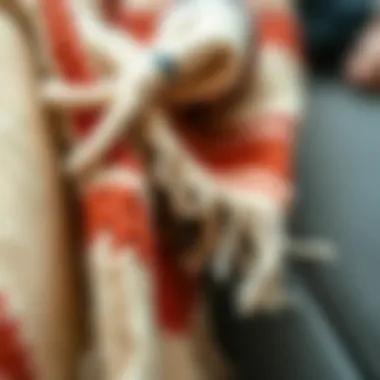
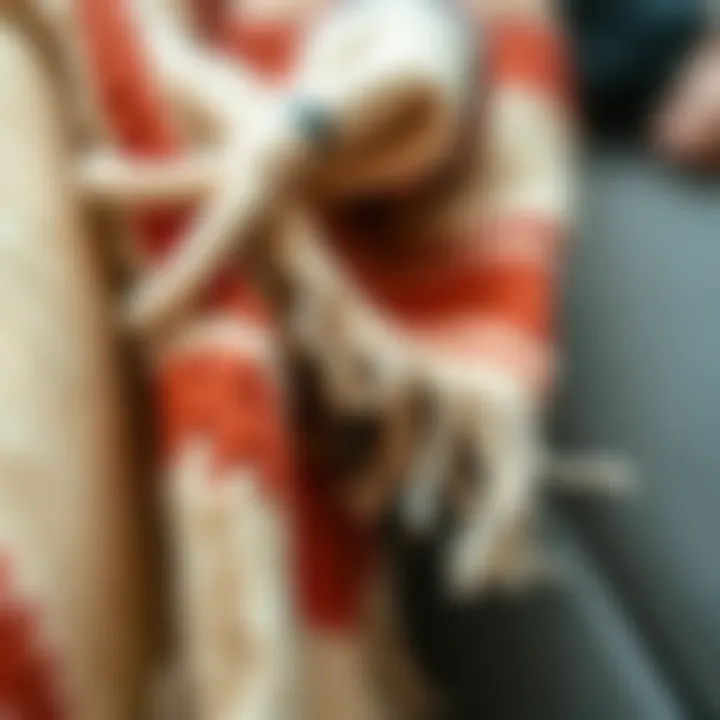
"You get what you pay for." When it comes to throws, this adage rings true more often than not.
Trends in Throw Design
The world of home decor is ever-evolving, and throws are no exception to this trend. Understanding the latest trends in throw design is crucial for anyone looking to enhance their living space. Not only do these trends influence aesthetic appeal, but they can also impact the comfort and functionality that throws provide. Staying informed about current styles can help individuals select pieces that resonate with their personal taste while contributing to a stylish and inviting atmosphere.
Emerging Patterns and Styles
As we step into the realm of throws, one cannot ignore the incredible breadth of patterns and styles emerging today. The harmony of colors, shapes, and textures is becoming even more pronounced in recent designs.
- Textured Throws: Throws featuring intricate weaves are making a comeback. These textured pieces add layers and depth to your space. Think of cable-knit blankets that are not just cozy, but also visually appealing.
- Abstract Designs: Abstract patterns that seem to tell a story have gained popularity. They provide a modern touch that can liven up any room.
- Nature-Inspired Prints: Prints that mimic natural elements, such as leaves or water patterns, are trending. These patterns not only bring the outdoors in but also promote a peaceful ambiance.
- Crossover Styles: The merging of traditional and contemporary styles is particularly noteworthy. A rustic plaid throw can now complement minimalist decor in unexpected ways.
By integrating these emerging patterns and styles into your home, you can make a statement that reflects both current design principles and your personality. This approach highlights the importance of throws in tying together the entirety of a decorative scheme.
Incorporating Throws into Seasonal Decor
When it comes to seasonal decor, throws provide unmatched versatility. Each season carries a distinct vibe and mood, and incorporating the right throws can seamlessly bridge these transitions. Here’s how:
- Spring Refresh: A light cotton throw in pastel shades can invigorate a room dulled by winter's cold.
- Summer Vibes: Consider lighter, breathable fabrics in vibrant colors or floral patterns to enhance outdoor spaces.
- Autumn Warmth: Cozy wool throws in rust and deep green hues can create a warm and inviting atmosphere as the weather turns cool.
- Winter Comfort: Throws made of heavier materials, like fleece, in dark jewel tones not only add warmth but can also create a feeling of indulgence.
Using throws to decorate seasonally allows for an easy refresh without major investment. Changing out your throws is like giving your home a little facelift, and the right choices can evoke feelings of nostalgia and warmth.
"The right throw can be the finishing touch that makes a room feel complete, marrying comfort with style."
Embracing trends in throw design is not just about keeping pace with fashion; it’s about personal expression and enhancing the quality of your living environment. By understanding these elements, homeowners, renters, and designers alike can curate spaces that are not only trend-forward but also deeply personal.
Creating Cozy Environments with Throws
Throws are more than mere decorative pieces; they are instrumental in creating an ambiance that feels inviting and warm. In a world where comfort is highly valued, the strategic use of throws can elevate the overall aesthetic of your living space, offering both function and flair. Throws help in establishing a focal point in a room, while also blending harmoniously with other elements of your décor. They can transform a stark, minimalist setting into a haven of warmth and comfort, making any room feel more lived-in and accessible.
Layering Techniques
Layering throws can dramatically enhance the visual interest of a space. It’s not just about having one cozy blanket slouched over a chair; it’s about playing with different textures, colors, and patterns to achieve depth and comfort.
- Mix Textures: Combine a chunky knit throw with a softer fleece one. This contrast adds a rich dimension to your décor.
- Play with Lengths: A longer throw can drape elegantly over the arm of a sofa, while a shorter one might be folded neatly on a chair.
- Use Multiple Throws: You can stack several throws on a single piece of furniture—each serving a different purpose, whether for warmth, style, or both.
Beyond aesthetics, layering throws offers practical advantages as well. For instance, it provides an easy way to change the look of your space according to the season. In the summer months, lighter throws might be preferable, while heavier, more textured options can create an inviting feel in the winter.
Color Coordination with Existing Decor
When it comes to choosing throws, color coordination is key to a well-balanced design. The colors of your throws should complement the existing palette of your room. It’s about finding harmony without sacrificing individuality.
- Complementary Colors: Look for throws that share hues with your current color scheme. A muted blue throw might beautifully tie together gray sofas and warm wooden accents.
- Accent Colors: Alternatively, you can select throws in shades that contrast your main colors. A vibrant red throw can serve as a striking accent against a neutral backdrop.
- Seasonal Touches: Don’t shy away from seasonal throws that reflect the mood of different times of the year. Soft pastels for spring, rich earthy tones for autumn; it can refresh your area simply and effectively.
Choosing the right throw can significantly enhance the overall warmth of your space while allowing for personal expression through color and texture.
In essence, creating cozy environments with throws is not merely about choosing a blanket to keep warm. It involves thoughtful consideration of how each piece interacts with its surroundings, layering techniques that inject personality, and a keen eye for color dynamics. By integrating these strategies, homeowners and designers alike can transform living spaces into inviting retreats that foster comfort and style.
Personalization and Customization
Personalization and customization in throw selection are not just for the sake of flair. They serve as a reflection of one's personality and style, allowing homeowners and renters alike to create spaces that resonate with their unique aesthetics. In today's world, where mass production often overshadows individuality, customizing a throw can make a statement that transcends mere decoration. This section will explore two key aspects—monogramming and embroidery options and choosing unique fabrics—that can truly elevate the appeal of throws in your living space.
Monogramming and Embroidery Options
Monogramming and embroidery provide a straightforward yet elegant way to impart a personal touch to throws. These options allow for the addition of initials, names, or even significant dates, transforming a simple accessory into a cherished keepsake. Incorporating such detail can do more than make your throw unique; it can narrate a story or commemorate a special moment.
When contemplating monogramming, consider the following:
- Font Style and Color: The font used can convey different moods. An ornate script might evoke a sense of tradition, while a clean, modern font could reflect a minimalist aesthetic. Matching the color of the thread to the throw's overall color scheme can create a seamless look or an eye-catching contrast;
- Placement: Where you position the embroidery matters too. A corner placement might add a subtle touch, while central positioning lends more prominence;
- Customization through Images: Beyond letters, some options allow for designs or symbols to be added, providing even greater flexibility in personalization.
In addition, the craft of embroidery elevates the feel of a throw. The texture and depth created by stitches can add an element of sophistication or warmth, depending on the approach taken. It makes the piece not just functional, but also a work of art that can be admired.
"Personalizing throws with monograms or embroidery is like adding a chapter to your home’s story, creating a narrative that feels both welcoming and distinctly yours."
Choosing Unique Fabrics for Individual Style
The fabric you select can tell a lot about your preferences and lifestyle. While many might default to conventional materials, considering less typical options can lead to more distinctive outcomes.
For instance:
- Linen: Known for its breathable properties, linen brings an earthy feel to spaces. It's perfect for warm climates and matches well with bohemian or rustic themes;
- Hemp: An eco-friendly choice, hemp offers durability and a natural look, appealing to those who lean towards sustainable living;
- Velvet: If you desire a touch of luxury, velvet delivers a rich texture that can easily elevate ordinary spaces into extraordinary ones.
- Faux Fur: For a cozy yet chic option, faux fur throws bring warmth and visual interest, perfect for making a statement in modern or glamorous interiors.
These materials not only align with aesthetic preferences but also complement functional needs. While some fabrics are better suited for warmth, others may provide breathability or easy maintenance. As you explore various textures and finishes, remember that each choice contributes to an atmosphere that encapsulates your personal style.
In sum, the realm of throws allows for ample innovation through personalization. By leveraging elements like monogramming and selecting unique fabrics, you create a home that reflects who you are, making your living space feel inviting and distinctly yours.
Culmination
In the journey of transforming a house into a warm and inviting home, throws play a crucial role that often goes underappreciated. This article has aimed to shine a light on various aspects of throws, covering materials, designs, and their practical aspects. Selecting the right throw can change the vibe of a room—think of it as the cherry on top that can enhance comfort while providing a visual focal point.
Understanding throws not only enriches your design choices but also helps in making sustainable selections. With the myriad of fabrics available—from plush wools to eco-friendly fibers—consumers are empowered to choose options that align with their values and aesthetic preferences. The importance of materials cannot be emphasized enough, as they not only affect feel and durability but also the overall ambiance of the space.
Summarizing Key Points
- Material Variety: Throws come in a multitude of fabrics including cotton, wool, and blends, each serving different needs from warmth to hypoallergenic properties.
- Styles and Designs: From classic to modern and everything in between, throws can complement any decor scheme.
- Customization Options: Personalized touches like monogramming make a throw not just a decorative element but also a meaningful keepsake.
- Care Considerations: Knowing how to maintain your throw ensures its longevity, making it a worthwhile investment.
- Cost Dynamics: Understanding the relationship between price and quality helps buyers make informed decisions without breaking the bank.
All of these factors work synergistically to guide the selection process, ensuring you make choices that reflect both practicality and personal style.
The Lasting Impact of Thoughtful Throw Selection
Being deliberate in your choice of throws does more than just beautify your space; it cultivates a sense of comfort and personality within your home. When you select throws that resonate with your individual taste and lifestyle, it invites a warmth that transcends mere decoration. A well-placed throw can become a piece of art, a conversation starter, or even a cherished item passed down through generations.
The choice of throws impacts not only personal comfort but also contributes to the overarching narrative of your home. It communicates values like sustainability if you opt for organic materials or reflects global influences with vibrant patterns from far-off cultures. A thoughtfully curated collection of throws can tell your story, showcasing your journey as an individual while creating a space that feels authentically yours.
Ultimately, the right throw is more than just fabric draped over a sofa—it serves as an embrace, inviting you and your guests to settle in, relax, and enjoy the unique ambiance of your living space.


